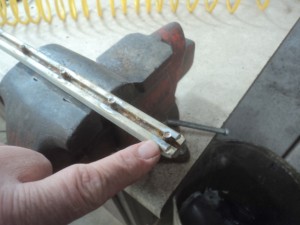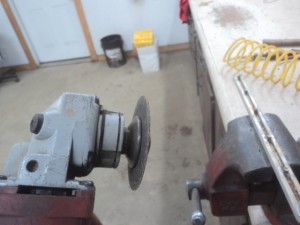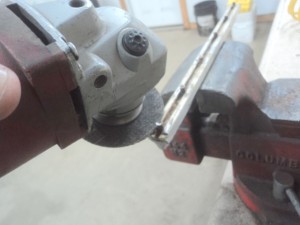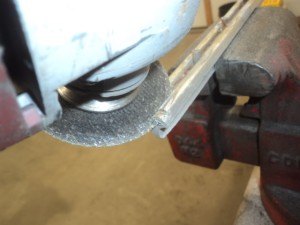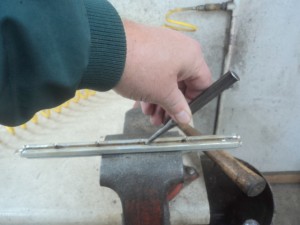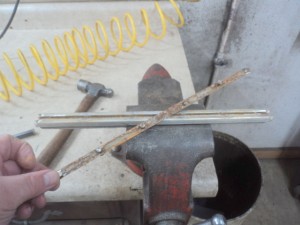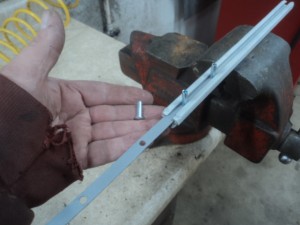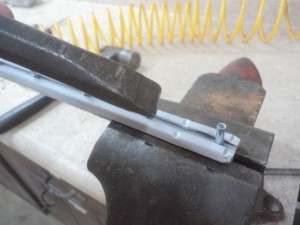Diablo Tracks
A track on a Diablo is made up of two lengths of conveyor belting, 43 extruded aluminum cleats and lacer clip attachments on each end. Tracks vary in length as they shrink over time due to the environment they are in. I have seen tracks as long as 107″ and as short as 104″ measured rubber to rubber (not including the lacers). Tracks shorter than 105-1/2″ start to get hard to pull together to get the lacer pins in place.
The best tracks are straight when laid on the floor, but often, they have some bow to them. If you laid a straight edge along them and found an inch or two of bow, that should be ok. Tracks with more than two inches of bow may rub against the tunnel while driving.
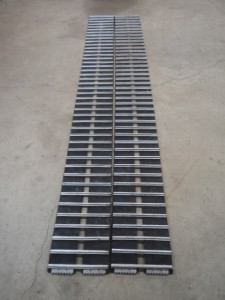
Weather-checking on the belting is common and most often of no issue. As long as the belting is not deteriorating and ripping, it is probably just fine.
Installing a “Matched in Length” pair of tracks is important to have them at similar tensions when adjusting the track tensioning jack bolts. Tracks that are within 1/2″ in length work well. More than that difference in length and you will have one tight track and one loose track on your Diablo. Remember, it is important to have both track tensioning jack bolts stick out the same on each side so that the gearbox is square in the chassis. Cocking the jack bolts to make up for tracks that are of different lengths only damages the bearings in the gearbox.
Early production tracks had small diameter washers on the cleat rivets. Later production tracks have larger washers. Sometimes tracks with small washers especially if they are rusty, will start to pull through the belting or the rivets pull through the washers. There is not much you can do to fix that other than look for a better track.
Some tracks are found to have row of washers missing on a number of cleats on a track. This happens when tracks are run loose and the tracks slap hard against the track guide by the Idler Sprockets.
My rule of thumb is 1 rivet missing on a cleat is ok. Two or more rivets missing and you should replace the cleat.
Aluminum Cleats
The aluminum cleats on a Diablo Track are extruded aluminum bars with a rivet rail and rivets in them. For the most part, they are pretty sturdy but can get bent if they get caught on a rock or something while you are out busting through the rough. Cleats can break too. Another issue you can have is the rivet washers get torn off. This can happen when washers get rusty or the cleat gets caught on something and pulls the washer through the rubber belting.
Refurbishing Cleats
If you have extra tracks, you might be able to save and refurbish cleats from it. The challenge is getting the rivet rail out of the old cleats. My experience with tracks is that some have cleats that come apart very easily and others do not come apart without breaking the rivet rail. It just a matter of rust and corrosion and how patient you want to be. This is how to refurbish a cleat:
– Slice out the “peen” in the aluminum with a cutting wheel. Some cleats have 2 “peens”; one on each end. Some cleats have one “peen” toward one end.
– Tap against a rivet with a punch to drive the rivet rail out. This is the hardest part of the process.
– Remove the old rivets from the rail. Straighten it out and clean the rail and the cleat. I sandblast these pieces.
– The rivets are a “hollow” end rivet. They are 3/16″ diameter and 5/8″ long.
– Tap the rivet rail with rivets back into the cleat. You will have to tap against the base of a rivet with a punch to get the rail back in.
– Use a dull chisel to install a new “peen” in the aluminum.
